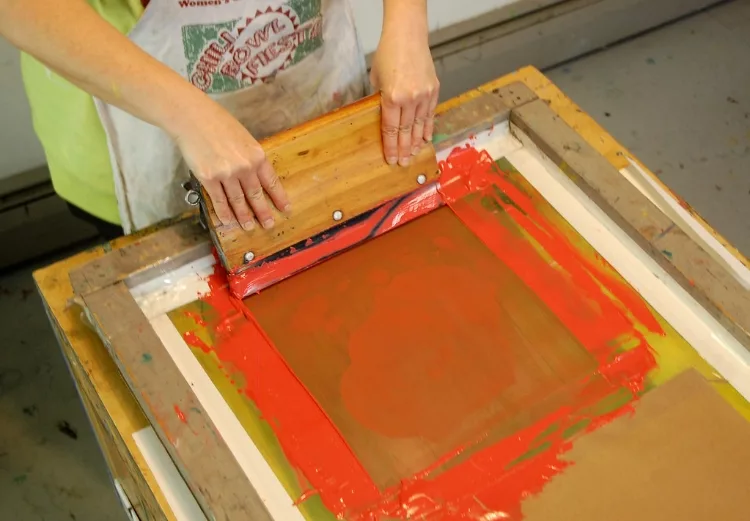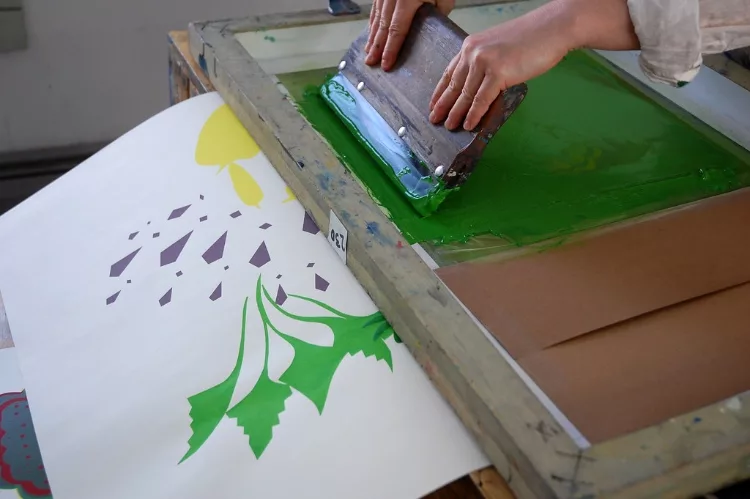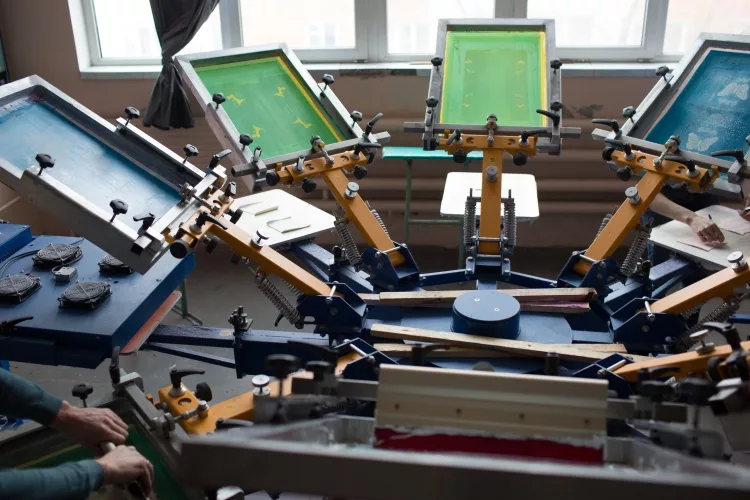What is Silk Screen Printing?
by Anthony Clark
The process of silk screening is often used to create prints on fabric, paper, or other material. It involves the use of a stencil to create a design on a screen made of fine mesh. Ink is then applied to the screen, and the excess is drained off. The screen is then placed against the material to be printed, and pressure is applied. This causes the ink to be forced through the screen and onto the material. Silk screening can be used for both simple and complex designs. It is a popular printing method because it produces high-quality prints at a relatively low cost.
Contents
What Does Silk Screen Printing Mean ?

Silk screening is a printing technique that uses a mesh screen to produce images on fabric or other materials. A squeegee is used to force ink through the mesh, and the resulting image is called a screen print. Silk screening can be used to produce a wide variety of images, including text, logos, and photographs.
The process can be used to create both large and small prints, and it is often used for advertising or promotional materials. Screen printing is a printing technique that uses a mesh screen to produce images on fabric or other materials. A squeegee is used to force ink through the mesh, and the resulting image is called a screen print. Silk screening can be used to produce a wide variety of images, including text, logos, and photographs. The process can be used to create both large and small prints, and it is often used for advertising or promotional materials.
Steps to Silk Screen Print
In order to silk screen print, you will need the following supplies:
- Silk Screen Frame
- Screen Printing Ink
- Squeegee
- Stencil (optional)
- T-Shirt or other cloth surface
1. Begin by setting up your silk screen frame. If you are using a stencil, place it in the frame now.
2. Next, load up your ink onto the squeegee. You will want to make sure that the ink is evenly distributed so that your print comes out correctly.
3. Apply pressure to the squeegee and run it over the stencil (or screen). Be sure to do this quickly and evenly in order to avoid any smudging.
4. Finally, carefully remove the stencil and allow the ink to dry. Your print should now be complete!
Benefits to Using Silk Screen Printing
There are many benefits to using silk screen printing for your business or organization. Some of the top benefits include:
1. Increased Visibility
Silk screening allows you to create large, bold prints that are sure to grab attention. This makes it a great choice for marketing materials and other promotional items.
2. Durable Prints
Silk screened prints are highly durable and resist fading over time. This makes them a great choice for items that will be used frequently or that will be exposed to harsh conditions.
3. Vibrant Colors
Silk screening produces vibrant colors that are sure to make an impression. This makes it a great choice for projects that require high-quality visuals.
If you're looking for a printing method that offers a variety of benefits, silk screening is a great option. Contact a printer today to learn more about this process and to get started on your next project.
When to Use Silk Screen Printing ?
Many artists that don't use the silk screen printing technique do not know its prevalence over other techniques. Independent and small-scale artists use the silk screen printing process to produce original work. However, large-scale manufacturers use screen printing to customize huge varieties of products. As an artist, you can use silk screen printing for large-scale and small-scale production. Hence, you can use the screen printing technique regardless of the class of artist you belong to.
1. Art Prints

One of the major tasks of artists is printing. They can print for commercial or personal purposes. Though screen printing may not be easy for non-professionals, artists have found it much easier in that they can make multiple copies of artworks from the scratch. Hence, they can sell a huge number of their artwork to their target customers and meet their demand at any given time.
Many a time, some artist uses screen printing to produce unique artwork. For this purpose, they create a stencil and apply unique color to it using a brush or squeegee. The practice of silk screen printing has become another better option of transferring art design on different canvas without any hassle.
2. Choice of Textile
The most common kind of textile used for silk screen printing purposes is the T-shirt and other apparel used for special events. Many a time, people order materials directly from companies for silk screen printing for charity, events, and other purposes. They also order flags, tote bags, and other basic human utilities for logo printing and other customization purposes.
Additionally, you can do silk screen printing on patterned fabrics whereby you can create your desired patterned fabric both on a small scale or industrial scale. Individual artists are known to create pattern fabric on a small scale while artists create patterned fabrics on a large scale.
Comparison Between Silk Screen and Digital Printing
In the printing industry, there are many silk screen fans. However, the advancements in technology have brought about a new method of printing which is fast reducing the popularity and practice of silk screen printing. Many a time, the choice of printing method depends on different factors.
Nowadays, digital printing is gaining widespread popularity among professional and DIY artists. All that is needed is an image editing software and a printer. Through digital printing, you will have unlimited access to print small customization orders because the process is easier to set up when compared to screen printing.
Considering actual printed images, the digital printing technology allows you to get sharper and better details. You can print small lettering or details such that they will be clear to see. In silkscreen printing, you can use different color shades and they will appear vibrantly. Screen printed apparel reveals your extent of professionalism. It can last longer on customized shirts than digitally printed shirts. Additionally, digital printing works perfectly for materials that are 100 percent cotton while screen printing can be done on nylon, plastic, and silk materials.
The major difference between screen and digital printing is the price. The amount you spend depends on the location where you are carrying out the printing task. That said, digital printing is cheaper because it is easy to set up. You don't need to hire a professional to perform the task. You can perform digital printing in any location. Silk printing is affordable to experienced artists because they can use one stencil on many materials. High-quality digital printing is expensive and the printers are not cheap.
Different Scale of Printing Task

If you desire to start your printing task, you should understand the kind of printing you can do at a given time and location. In this section, I will tell you the kind of printing you can do.
1. Home Printing
If you desire to practice your printing skills at home, you can set up your printing apparatus easily. To do this, you need to set up the necessary materials like silkscreen, ink, squeegee, and frame. You also need a dark room, 250-watt bulb, photo emulsion, and glove to make your stencil. You can approach a local store to purchase these items.
2. Small-Scale Printing
Artists and upcoming printers practice small-scale printing for income generation or to execute personal projects. For this purpose, you can practice silk screen printing or digital printing. However, you need to consider the volume of work you need to do before choosing the method to use. Small-scale printers can handle projects like t-shirt, banners, key chains, and other bulk printing tasks. You can also customize your own apparel for special events and programs.
3. Mass Market Printing
Mass market printing is majorly practiced by professional artists. As an expert in printing, you can screen print on tote bags, t-shirts, and posters. These materials are sold in large quantities in order to earn extra income. Most artists make mass printing as their financial source because they handle large scale company orders. For this purpose, you can consider silk screen printing or digital printing, depending on the kind of material to handle.
Summary of Silk Screen Printing
The table below summarizes the types of printing and points to note.
| Types of Printing | Points to Note |
| Home printing | It is meant for personal printing tasks. |
| Small scale printing | It is meant for handling small printing tasks. |
| Mass Market printing | It is meant for handling huge printing tasks for companies and advertising companies. |
Conclusion on Silk Screen Printing Topic
The process of silk screening is a great way to produce large quantities of prints in a short amount of time. It can be used for a variety of different applications, from printing T-shirts to printing posters. If you need high quality prints quickly, silk screening may be the perfect solution for you.
 |  |  |  |

About Anthony Clark
Anthony Clark always had a passion for digital drawing and printing ever since he was young. He would wander around his parents' house in Phoenix, Arizona drawing various things with his older digital tablet. Be it just a memory collection or a portrayal of anything: objects, parents, school, events, etc. He received his BA in Graphic Design at San Jose State University - the heart of Silicon Valley. Now Mr. Clark is excited to present his experience coupled with some colorful dips to help shape the future of printing.
Thoughts on "What is Silk Screen Printing?"
 |  |  |  |
Get some FREE Gifts. Or latest free printing books here.
Disable Ad block to reveal all the secret. Once done, hit a button below
 |  |  |  |